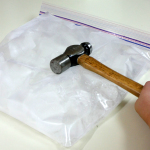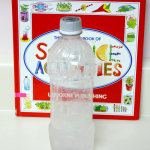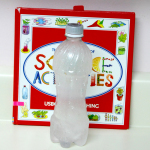Science With Children: Two Experiments With Ice
I’m not sure why, but my preschooler loves to play with ice. Following are two experiments using ice…one involves food coloring, which makes it even more fun for kids!
Disclosure: I was not compensated for this post. I am an affiliate of Amazon, and will receive a small commission if a link on this blog is used to make a purchase.
Salt and Ice Experiment
This idea actually came from a LEGO Friends video on the LEGO web site! It’s rather simple and very inexpensive.
You will need:
- Bowls – one or two per scientist
- Water
- Freezer
- Large Baking Dish or Pan
- Salt
- Food Coloring
What To Do
- Pour water into bowls and freeze. After they have frozen solid, place ice in large pan. (Larger, flat side should be down, with the rounded part facing up.)
- Shake salt generously over ice. Watch how the ice cracks.
- To make cracks more visible, squeeze drops of food coloring on the ice.
My four-year-old went a little crazy with the food coloring, but that’s ok. She had lots of fun with this experiment!
Why It Works
Salt lowers the freezing point of water. This is why salt is used on icy roads in the winter. If your inquisitive scientist would like more details, there is an interesting article on abouteducation.com.
Air Getting Colder Experiment
From the The Usborne Book of Science Activities, Volume 2. This is a great experiment to do if you are studying air and weather.
What You Need
- Crushed ice (or crush ice cubes in a gallon freezer bag with the side of a hammer)
- Small plastic water or soda bottle with lid (the liter-sized bottle suggested in the book did not work for us)
What To Do
Put the ice as quickly as you can into the plastic bottle, and put the lid on. Shake the bottle and put it on the counter. As the air cools, it will pull in the sides of the bottle.
Why It Works
When air is cooled it contracts (shrinks), and no empty space is left inside the bottle. There is a very informative article for older students at this link.
Note: this experiment wasn’t quite as fun as the Salt and Ice Experiment (above). It took awhile experimenting with different sized bottles. By the time we found that the experiment worked with the small bottle, we were both tired of it! I’m glad it finally worked, though: visuals and hands-on experimenting make learning fun!
What are some of your favorite science experiments for kids?
Copyright 2014 Kathryn Depew
Disclosure: I was not compensated for this post. I am an affiliate of Amazon, and will receive a small commission if a link on this blog is used to make a purchase.






Leave a Reply